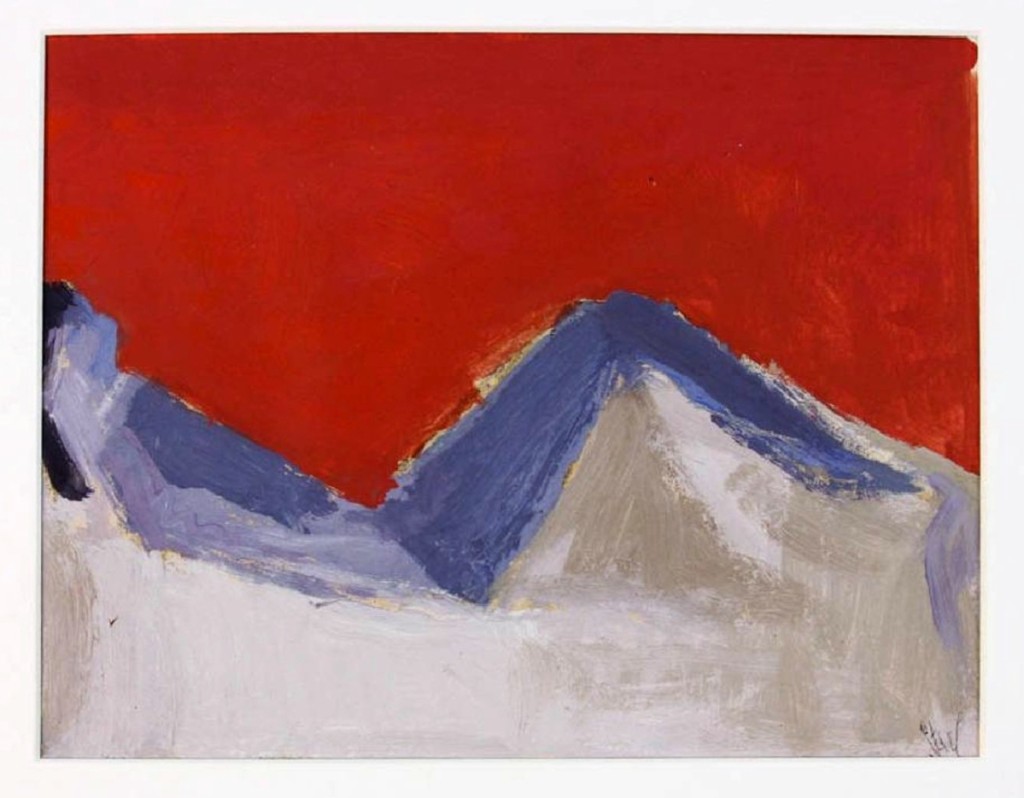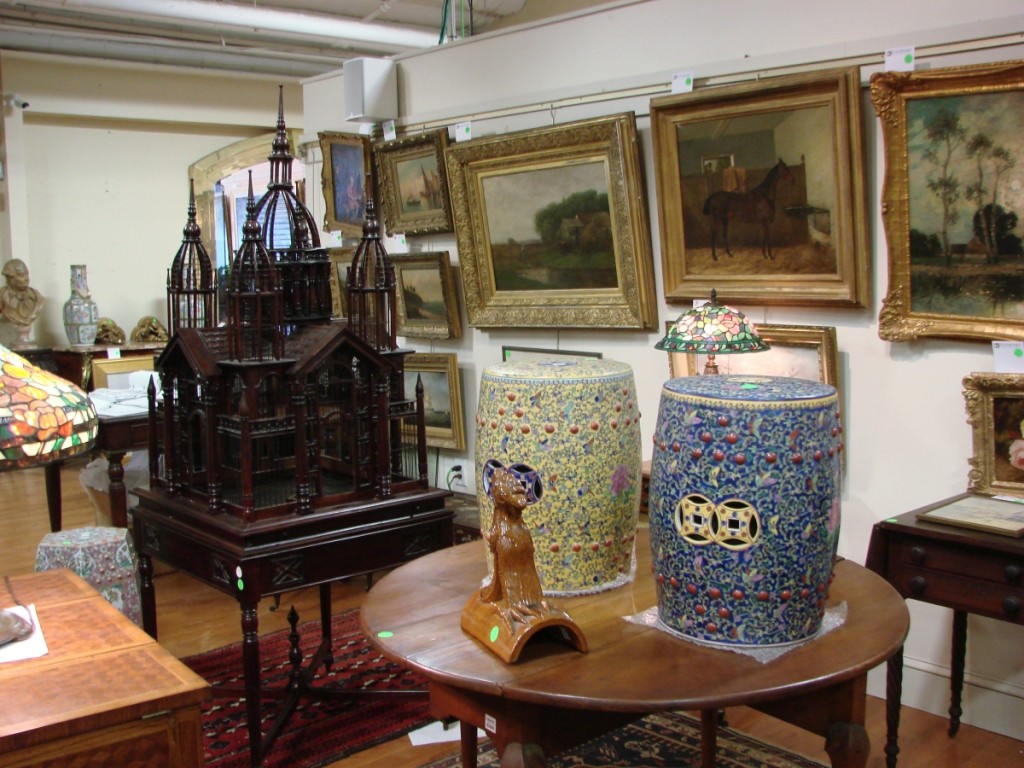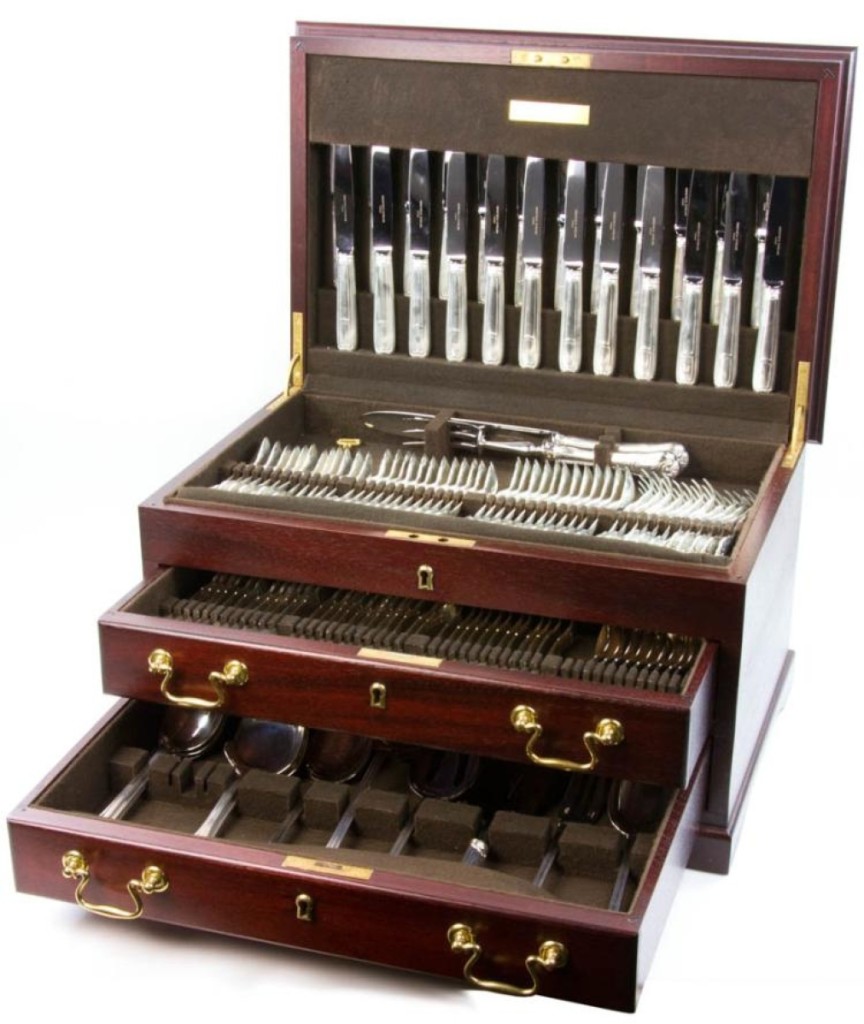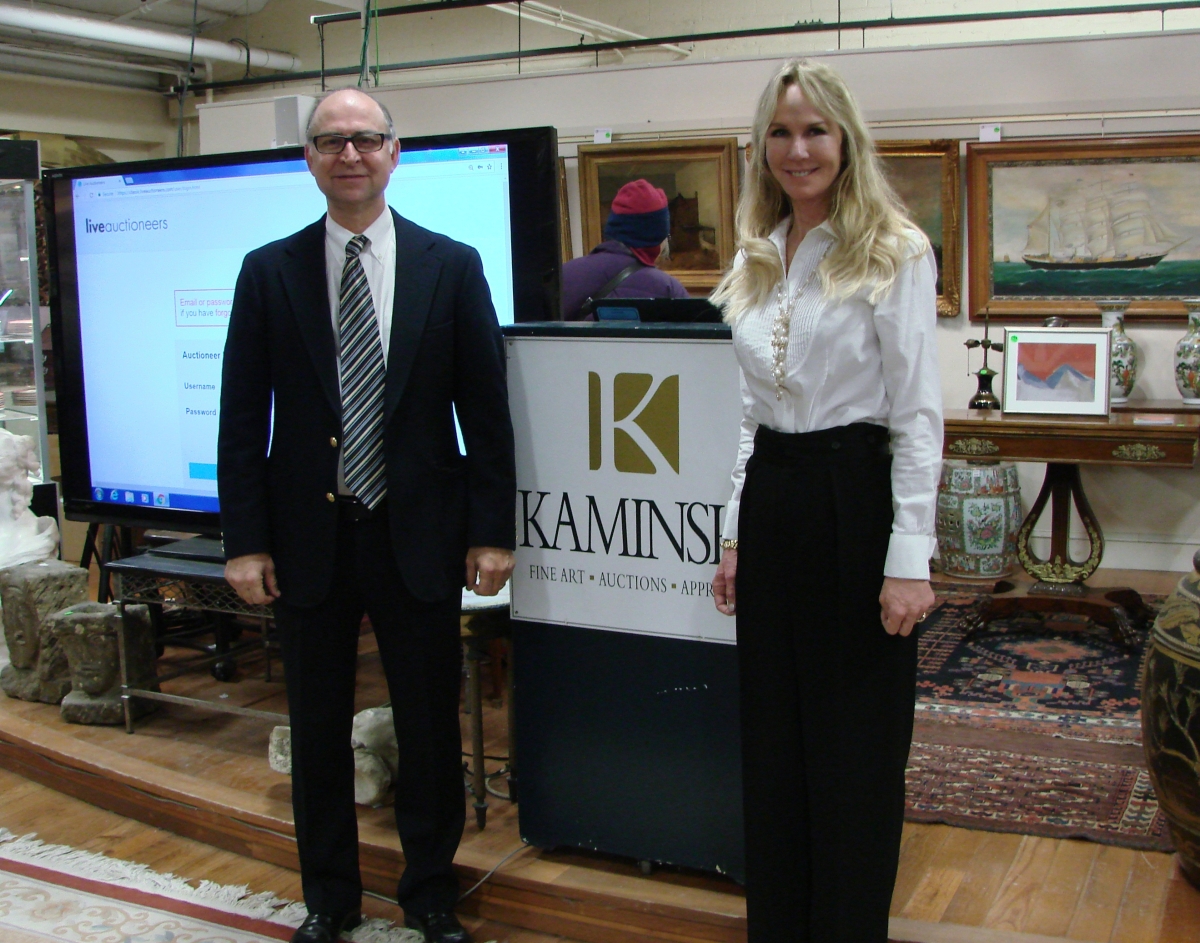
The top-selling lot of the two-day sale, as expected, was “Blue Nude” painted in 1955 by Nicolas de Stael, a well-known French abstract painter. Kaminski had advertised it in Europe to attract European buyers and one of them paid $84,000 for it.
Review and Onsite Photos by Rick Russack
BEVERLY, MASS. – Frank Kaminski’s New Year’s weekend sale was full of surprises, but the top selling lot did not surprise anyone. It was a newly discovered oil on paper version of “Blue Nude” by French painter Nicolas de Stael (1914-1955). Kaminski said he thought it may have been a study for a larger version of the same painting. De Stael was a successful abstract painter, influenced by Picasso, Cezanne and Matisse, who committed suicide in 1955 at the age of 41. In the early 1950s, he was represented by Paul Rosenberg, a New York gallery owner, who mounted several successful exhibitions of the artist’s work. This painting sold for $84,000 to a European phone bidder. The painting exceeded its estimate, and Kaminski later said the consignor was very pleased with the result.
Prior to the sale, Kaminski had said he expected it do well, based on the presale interest. “I think we promoted it well,” he said. “When we have things like that, we advertise them in European publications, like the Antiques Trade Gazette in London, as well as the American publications. We want to be sure we’re reaching those European buyers.” Other portions of the sale also did well. Some of the silver brought strong prices, as did jewelry, Oriental items, European furniture and decorative arts, while bargains were to be had in the selection of American furniture.
Even the auctioneer was surprised by the interest in a collection of smoking pipes sold during the first session of the weekend. A large grouping of well more than 150 pipes and humidors had been divided into several lots with modest estimates. Almost all sold well over the estimates, and one lot, two limited edition Alfred Dunhill pipes in original boxes, reached $1,560, nearly four times the estimate. One of these pipes, number 174/250, was “Sherlock Holmes and the Centenary of A Study in Scarlet” and the other was a 1989 special Christmas pipe, of which only 350 were produced. All the pipes in this collection had been smoked, and when the collector’s widow brought them in to see if they might have any value, she said that no one in her family had any interest in the collection. In all, the collection grossed $12,870, resulting in a very pleased lady.
Also surprising Kaminski and the audience was a 50-inch world globe, mounted in a large, well-carved walnut stand made by Kittinger. Estimated at $2,500, it finished at $9,600. Not all surprises were pleasant ones, however. American furniture prices were low. An Eighteenth Century Queen Anne cherry server made only $540, a Chippendale slant-lid desk reached just $720, and an exceptional mahogany, New York lyre-based card table with ormolu mounts earned a modest $1,800. The same price was obtained for a classical Empire mahogany sofa, also with ormolu mount and recent appropriate upholstery. As he was selling it, Kaminski commented that the upholstery probably cost more than the piece was selling for.

A portion of the material on display during the preview, including the mahogany birdcage and some of the paintings.
This sale showed why auctions are still fun. Included were 11 limited edition prints and exhibition posters by Roy Lichtenstein and Andy Warhol, being sold individually. A local collector had decided that he wanted all 11 lots. Roy Lichtenstein’s 1969 limited edition lithograph “Pyramids” was the first of the lots to be sold. As the bidding began, the collector, with his paddle held high, loudly told Kaminski, “I want it and I’m going to own it” and he did, paying $6,000 for it. As the other lots were being sold, the collector jumped bids $1,000 or $2,000 at a time, while telling Kaminski to “hurry up. I have no patience.” Once, as Kaminski was waiting for a phone bidder to decide, the collector exclaimed, “This is painful to me. Just knock it down.” The rest of the bidders in the room were enjoying the show, loudly rooting for him and encouraging Kaminski to quickly sell him the lot.
By the time the 11 lots had been sold, the collector had paid $29,430 for them, against the high estimate of $18,900. He later said, “I don’t have any Lichtensteins or Warhols and I really wanted them. I love the stuff.” The same collector bought several other items at the sale.
“It came from a Park Avenue estate and it’s one of the nicest sets of silver we’ve ever sold,” said Kaminski as he offered a 142-piece sterling silver flatware service for 12, plus serving pieces, by Christofle, in the Dupleix pattern. The pattern was produced between 2001 and 2006. The set had approximately 269 troy ounces of silver and was housed in a fine mahogany case with two drawers. Finishing at $18,000, it far exceeded the $7,000 estimate.

Bringing more than twice the estimate, at $18,000, this 142-piece Christofle Dupleix pattern sterling silver flatware set was in a mahogany case The pattern was produced between 2001 and 2006.
There were several lots of Georg Jensen and Jensen-style silver, with a Jensen-style sterling silver Blossom pattern tray, 27¼ by 17½ inches, leading the selection, as it finished at $3,240. A Tiffany & Co. sterling silver Faneuil pattern flatware service for 12 with 360 pieces, sold for $14,440. With an approximate weight of 329 ounces, it had nine different type of forks, 13 types of spoons and more.
Frank Kaminski got his start in the antiques business at a young age. “When I was about 6 years old my family bought a house in Stoneham, Mass., and there was a trunk in the attic that had belonged to a veteran of the Spanish American war. I was fascinated with the stuff,” he recalled. One thing led to another, and as a teenager he was selling at the Revere flea market, well-known to Boston area collectors and which still exists, although not quite what many remember.
“I was selling copper and brass stuff from junk yards and things that were left behind in my uncle’s rooming houses. By the time I was 14, I was working at Carl Stinson’s auctions as a runner and lugging stuff,” he continued. “I started doing the Amherst, N.H., flea market, and later Brimfield, and coming home sometimes with $1,000 or $2,000 for a weekend. When I was 17, I hired an auctioneer to do a sale in my backyard and found that I really loved auctions. So I was working for Stinson, buying stuff at Skinner and anywhere else I could.
“Thirty-one years ago, in 1986, I conducted my first auction on my own. It was an onsite sale in Harvard Square, and we had a very interesting painting by Elmer Crowell, the decoy carver. Jim Bakker, another local auctioneer, was my mentor and I took classes at the Danforth Museum school on fine art and antiques. In those classes, I learned about Asian antiques, Oriental rugs and paintings.”
Kaminski said this experience grew into his company. “We now conduct a two-day sale about every month. We have offices in West Palm Beach, Fla., and Santa Barbara, Calif. We actively use Twitter, Instagram and Facebook to promote our sales, and one of our full-time people takes care of that. In 2013, I had the fantastic experience of selling the Oprah Winfrey collection. We decided to do that sale on the West Coast. I met a whole different group of people with that sale. In April, I’ll be doing another celebrity sale – someone equally as well-known as Oprah and it will be a two- or three-day sale. I can’t talk about that publicly yet.” When that sale is announced, Kaminski could legitimately lay claim to being “The Auctioneer to the Stars.”
After the sale, Kaminski said, “This was a sale full of surprises. The ‘Blue Nude’ was a pleasant one as was the large globe and some of the silver. Everyone was surprised at the response to the collection of pipes and some of the jewelry, especially watches, were strong. American furniture was disappointing, but, overall, I’d call it a successful sale.”
Prices reported include the buyer’s premium.
For information, 978-927-2223 or www.kaminskiauctions.com.





























